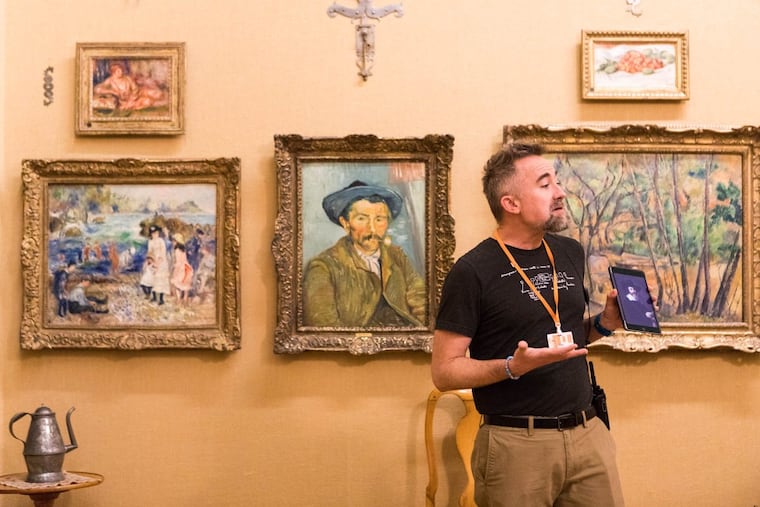Art Team is Barnes Foundation's new twist on visitor 'engagement'
Bye-bye, audio guides. Barnes visitors now rely on human beings for information - delivered in conversation and pop-up gallery talks.

Clay Cofer, standing off to the side of the central gallery at the Barnes Foundation, talks a bit of history. Visitors crowd around him as he holds up an iPad with pictures for everyone to see.
He is showing photographs of the Barnes' Merion grounds, once home to the paintings now hanging in replicated galleries on the Benjamin Franklin Parkway.
"These works," Cofer says, showing the iPad all around, "are arranged exactly as you see here." A roomful of eyes follow the iPad with its glowing images of Merion showing what is now all around in the gallery.
So what was once in Merion is now replicated in Philadelphia and is translated into digital imagery of Merion — shown to young and old attracted to the Barnes on its free first Sunday of February.
On this particular cold and drizzly Sunday, the galleries are not as packed as they might be. It is about six months into a new Barnes program – that museum officials have dubbed the "Art Team" – that seeks to replace the staple of audio tours with actual, responsive people, like Cofer.
It is one step on the endless and elusive pathway of "audience engagement."
You loved the audio, now try the guides
The Art Team has been steeped in Barnes history – institutional and aesthetic – and can converse and answer questions. Bye-bye, audio tour guides.
"He was great," said Mose Orbe, 30, a New Jersey engineer in town for an evening concert. Orbe caught Cofer's rap in a small gallery filled with a Goya, a Renoir, a Manet, a de Chirico, and several other paintings, and pieces of ironwork and furniture.
"Goya is a very important anchor from the past," Cofer said to the people crowding the room. He swiped through iPad images. Back and forth.
Goya harks back to Frans Hals, he told them. Manet, across the room, relates to Hals, as well. Consider Goya's brushstrokes, said Cofer. Consider the rosy complexion on his portrait here. Is it not like the rosy complexion of the Renoir portrait far down on the wall?
Visitors watch Cofer's almost magical manipulation of his iPad images. And then, five or so minutes are up and he's gone.
"Before he talked about the Goya, he talked about this piece here," Orbe said, gesturing at de Chirico's Sophocles and Euripides (1925). "The name of the artist escapes me, but what he said about it doesn't – I recall it vividly. It gave me a lot of appreciation for that piece and for the Goya piece. I thought he was well informed, speaks well, clearly, and he seems passionate about his material."
Cofer, 40, who has a doctorate in classical archaeology, is one of the eight-person Barnes Art Team. He's also a photographer and considers the Art Team "a unique combination of the things that interest me" – everything from public education to the Barnes' history of involvement with horticulture.
The all-important ‘human layer’
The Art Team is part of the Barnes' continuing effort to deepen its ties with its audience. Initiated by Shelley Bernstein, chief experience officer and deputy director of audience engagement, probably best known for her work with digital technology, the Art Team is notable for its relative lack of tech, at least for now.
"You begin with the most meaningful thing first," Bernstein said, alluding to engagement efforts. "So this is what we call the human-interaction layer. It's not about technology. It's not about providing people with a thing or device. It's thinking about what human interaction should be in the galleries and what we want that to be and trying to get that right before layering in other things."
First came some testing. Perhaps surprisingly, Bernstein discovered that people spent a lot more time in the galleries without an audio tour guide (110 minutes) than with one (88 minutes).
Why? Visitors always said they love and want the audio tour, she said. But they spend less time with the art when an audio tour is in play. People want to talk to one another. They even remove the audio tours.
Bernstein checked with colleagues at other institutions, notably the Broad museum in Los Angeles, which has assigned a group to do everything from taking tickets to chatting about the collection with visitors.
The Art Team is a result of these conversations and simultaneous visitor research. Audio tours were retired. Visitors were launched tech-naked.
Pop-up talks and private moments
"Now the pop-up talks are spontaneous, when there are a lot of people in the room," said Martha Lucy, Barnes deputy director for research, interpretation, and education. Art Team members also will engage visitors in conversation.
Bernstein said few visitors felt the Art Team was "pushy" in conversation, research showed. "Maybe one percent of visitors said things like, 'They interrupted my visit,' " she said.
Lucy added, "You have to read body language to see if somebody is in the gallery and they want to be on their own, not talking with anybody."
The Art Team will be on duty for six months or so before any serious fiddling is done with the visitor experience.
Bernstein said one new tech device is due this month, and another, which delivers content to a watch, is awaiting funding.
"So the team is just one part of a larger strategy," Bernstein said. "Until I get all three things on the floor, I can't measure effectively satisfaction and learning rates. End of story. I can tell you … the human layer is the pivotal layer."